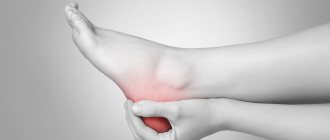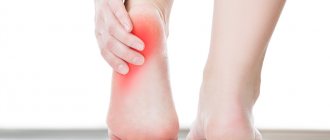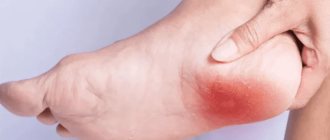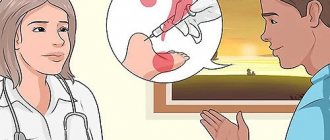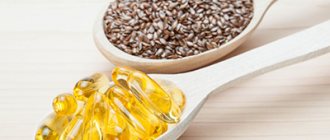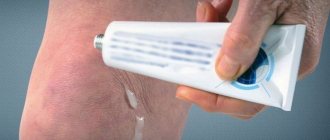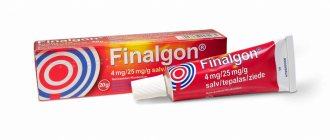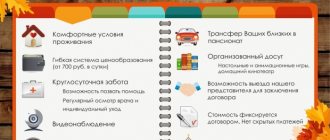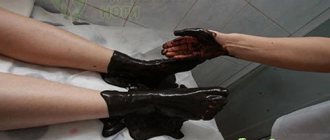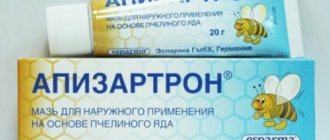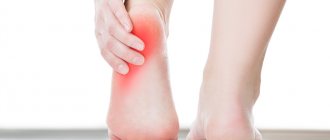Heel spur (fasciitis) is an inflammation of the fascia of the heel, manifested by the appearance of a bone growth. At any stage of the disease, the patient experiences severe pain.
Failure to comply with hygiene rules and low immunity often lead to the fact that the bone spur becomes infected and becomes inflamed again.
Treatment of heel spurs with medication gives good results: more than 90% of patients get rid of the heel spur without surgery. What medications should I take for heel spurs?
In this article we will talk about the basic principles of treating fasciitis using various groups of medications.
Attention! This article is for informational purposes only! Only a doctor can prescribe medications. Do not self-medicate to avoid side effects and worsening the disease.
How to treat heel spurs with medications?
Before treating a heel spur with medication, a diagnosis and assessment of the patient's condition is required. The main diagnostic method is radiography. The picture shows how big the spur is and how damaged the soft tissue is.
A blood test is also informative; it can be used to judge the degree of the inflammatory process. Depending on this, the doctor prescribes treatment.
The main goals of drug treatment for fasciitis are:
- Reduce the pain caused by the thorn.
- Stop the inflammatory process of the fascia.
- Relieve swelling and normalize the condition of the foot.
Which doctor treats heel spurs? Orthopedic doctors treat fasciitis. If your hospital or clinic does not have such a specialist, then you need to contact a surgeon or traumatologist.
Spur symptoms
The patient himself can guess that he has such a disease.
Several characteristic symptoms will tell him about this:
- Feeling of discomfort when resting on the heel or full foot. There is a feeling that a person has stepped on a nail.
- As the load increases, the pain worsens. In the future, it will be present even when the person is at rest.
- Formation of a growth , which can be confused with a continuation of the foot bone (if neglected).
A person with heel spur disease can also be identified among passers-by. Typically, such patients have a distorted gait. They strive to “unload” the leg from the load.
Treatment of heel spurs: tablets and treatment regimens
The standard treatment regimen for fasciitis includes the use of the following medications:
- Painkillers and anti-inflammatory tablets of general action. For heel spurs, do not use sedatives or narcotic painkillers.
- Local anti-inflammatory drugs in the form of ointments, compresses, lotions.
- Additional medications with a general strengthening effect: vitamins B and C, immunostimulants, dietary supplements to improve metabolism, etc.
Usually this scheme is effective and within 1-6 months the patient gets rid of heel spurs. If you combine medication with the right lifestyle and orthopedic means, the cure will come much faster.
For example, these heel supports for heel spurs effectively relieve pressure on the heel, reducing pressure on the fascia. As a result of their regular wear, the heel tissues heal much faster.
If the above treatment regimen does not help, then the doctor prescribes hormone-containing medications.
Attention! Prescribing and taking steroid (hormonal) drugs on your own is strictly prohibited!
The doctor prescribes an individual dosage for each person, which depends on the patient’s condition, age, weight and gender.
Causes of heel spurs
Medical specialists have identified several reasons that provoke the formation of microtrauma:
Flat feet
- Congenital or acquired flat feet are the most common cause (in approximately 90% of patients it causes the development of the disease).
- Leg injuries in which soft tissue or tendons are damaged.
- Overweight or pregnancy - a growth forms when the foot is put under prolonged stress.
- Disorders of the circulatory system in the lower extremities.
- Some types of chronic diseases : diabetes, gout and rheumatoid arthritis.
- Wearing high-heeled shoes for a long time.
- Excessive leg training can provoke the development of spurs.
According to statistics, 70-80% of the total number of patients are women over 40 years of age.
Painkillers for heel spurs
To eliminate pain caused by inflamed fascia, agents that slow down cyclooxygenase, an enzyme involved in the production of prostaglandins, are used. Such drugs are taken orally, i.e. through the mouth.
Painkillers for heel spurs have the following effects:
- reducing vascular permeability and improving microcirculation;
- anti-inflammatory effect due to blocking the formation of bradykinin;
- analgesic effect for 3-12 hours.
What pills to take for heel spur pain relief?
Most often doctors prescribe:
Ibuprofen
One of the most effective analgesic drugs with a strong anti-inflammatory effect. Has a minimum of contraindications.
Ibuprofen for heel spurs (the doctor will prescribe how to take it individually) is well tolerated and does not have a negative effect on the joints.
Long-term treatment with Ibuprofen is not allowed in elderly people and people with gastrointestinal diseases. When combined with coffee, the analgesic effect is greatly enhanced, but this combination has an extremely bad effect on the heart.
Flexen
A drug based on ketoprofen, which has a more pronounced effect than Ibuprofen. The disadvantages of this drug are the high cost of capsules and the presence of side effects. Flexen is also available in the form of a gel with an analgesic effect.
Voltaren
The tablets contain diclofenac. If you have a painful and progressive heel spur, treatment with diclofenac will be most effective. The medicine suppresses foci of inflammation, relieves swelling and improves the metabolic functions of the tissues of the heel fascia. Voltaren and other diclofenac-based medications must be taken with precise dosage.
Indomethacin
Currently, indomethacin tablets are considered an obsolete drug due to the emergence of more effective and safe drugs. However, doctors often recommend indomentacin, advising it to be taken with plenty of water to reduce side effects.
Also, the list of frequently prescribed non-steroidal anti-inflammatory tablets includes: Naproxen, Etodolac, Nemisulide, Amidopyrine, etc. Each medicine has its own characteristics, so only a specialist can prescribe it after diagnostic measures.
Local medications for heel spurs
Local non-steroidal anti-inflammatory drugs for the treatment of heel spurs are used in the form of ointments and compresses. The most popular and effective external local remedies are:
Dimexide solution
A cheap product in the form of a solution, sold without a prescription at any pharmacy. Dimexide against heel spurs is used in the form of a lotion or compress.
The peculiarity of this drug is the ability to penetrate into the deep layers of the epidermis and muscle tissue, stopping the inflammatory process. The drug is also an excellent antiseptic, preventing the insemination of the fascia by pathogenic microorganisms.
Compress recipe: dissolve 50 ml of Dimexide in 200 ml of warm water. Moisten a gauze swab with the resulting solution and attach it to the heel using an adhesive plaster or bandage. Walk for 3-6 hours. Apply the compress daily until the thorn is removed.
Indomethacin ointment 10%
A popular inexpensive remedy with anti-inflammatory and anti-edematous effects. The ointment increases joint mobility, eliminating pain and stiffness.
Indomethacin for heel spurs is used 2-3 times a day. The daily dose of 10% ointment should not exceed 10 cm. If you have certain cardiovascular diseases, this ointment is not recommended.
Dolobene
Gel with analgesic effect based on dexpanthenol and sodium heparin. It is characterized by rapid absorption and may cause allergic reactions.
Dolobene-gel is used in electro- and ionopharesis, as well as in other physiotherapy procedures for heel spurs as a conductive agent.
Capsicam
Warming ointment with local irritant action. The main substance in the composition is capsaicin, which irritates receptors. The ointment improves blood supply to the area of the heel next to the spur.
Caciques and other external agents with a warming effect should not be used in the presence of infectious irritation, abscesses, or open wounds of the feet.
Also used in the treatment of fasciitis: Nise-gel, Nurofen, Finalgel, Voltaren, etc. Ointments and gels must be used regularly, and not occasionally, only with constant use they give a therapeutic effect.
Proper heel unloading is of great importance in local therapy. To do this, choose the insoles to wear with spurs that are best suited for you.
How is ultrasound therapy performed for heel spurs?
The physiotherapy procedure is carried out on an outpatient basis. To conduct an ultrasound therapy session, modern safe devices UZT-1, Procton-1, Gamma, etc. are used. The procedure is carried out in a physiotherapy room.
Before referring a patient for an ultrasound, the attending physician must take an x-ray. An X-ray of a heel spur will help determine the location of the spur for ultrasonic treatment.
A course of ultrasound treatment consists of 5-20 procedures depending on the patient’s condition and the size of the growth. The duration of the session depends on the area of the inflamed fascia and is 3-15 minutes.
There are two methods of influencing the affected fascia with ultrasound radiation, based on the ability of ultrasound radiation to increase the permeability of cell membranes, which allows the delivery of drug molecules deep into the affected fascia:
- Ultrasound treatment with conventional gel or non-steroidal anti-inflammatory agent.
- Ultraphonophoresis with hydrocortisone.
The first method involves exposure to ultrasonic radiation with a frequency of 800-3000 Hz for a duration of 5 to 15 minutes. Before starting the procedure, ultrasound gel or water-based anti-inflammatory ointment is applied to the treatment area.
Dimexide, indomethacin, etc. can be used as ointments. Pyatkashpor Strengthened cream has an excellent absorbent effect, helping to reduce spurs.
With high-frequency exposure, the heel spur is crushed by ultrasound, however, such enhanced radiation can negatively affect surrounding tissues, so its effect does not exceed 1-2 minutes. This method can only remove a small thorn.
As a rule, a more effective method is used to remove a large build-up - crushing the heel spur using shock wave therapy or laser treatment.
Heel spur: hormone-based medications
Hormonal drugs to get rid of spurs are used when non-steroidal drugs are powerless. We can say that steroid ointments and injections are the last option to avoid surgery to remove the growth.
Steroid medications for the treatment of heel spurs should only be used under the supervision of a physician! They have many contraindications, especially for women.
Such drugs include:
Hydrocortisone
Available in the form of an ointment. Apply to the affected heel 2 times a day. The duration of treatment with hydrocortisone is no more than 2 weeks.
Active hormones in the ointment suppress inflammatory mediators and normalize blood circulation.
Diprospan
Long-acting corticoid ointment. It is used in the presence of inflammation of the fascia and tendons. Also available in the form of a solution for injections.
It is injected directly into the spine, having a strong absorbing effect. The frequency of Diprospan injections is determined by the attending physician.
Attention! Frequent injections of medication to block heel spurs can cause the plantar fascia to rupture, which can lead to profound disability. That is why the uncontrolled use of hormonal injections is strictly prohibited.
Medicines for the treatment of heel spurs in the form of a cream based on betamethasone and analogues, for example, Beloderm, Elokom, Advantan, etc., are also used as hormonal agents.
What is a heel spur?
Heel spur is a chronic disease. Among medical professionals, it is better known as a heel spur. In the area of the suspended ligament or plantar fascia, a microtrauma is formed, presented in the form of bone growth.
This pathology is often provoked by another disease - plantar fasciitis, inflammation of the fascia of the foot. The size of the spur can reach up to 12 mm. Outwardly, such a formation may not be noticeable, but the person will experience severe discomfort and pain.
Heel spurs and fasciitis
Ointments based on medical bile
If you have a disease such as a heel spur, treatment with medications can give a good result. However, due to the fact that all pharmaceuticals have side effects, they cannot be used for a long time. Meanwhile, the heel fascia requires special care even after remission.
In this case, it is recommended to use specialized creams created for people with heel spurs or a tendency to form them.
Such products have a number of distinctive features in comparison with pharmaceuticals:
- consist mainly of natural ingredients;
- can be used for a long time;
- do not have a harmful effect on the body;
- can be used as prophylaxis.
What ointments help with heel spurs in the acute stage and for prevention? The ointments from the Pyatkashpor line have these characteristics.
The series includes 3 types of ointments with different percentages of natural medical bile. This substance effectively and carefully removes bone thorns, softens the skin of the heels, and also has an antibacterial and disinfectant effect.
During an exacerbation, you can use “Pyatkospor Strengthened” with a high level of bile content. For prevention, “Pyatkospor Prophylactic” with a reduced content of medical bile in its composition is perfect.
At the initial stage of the disease with spurs, use these ointments and the bone-salt growth will bother you much less.
How to increase the effectiveness of medications in the treatment of heel spurs?
With drug therapy, to successfully get rid of fasciitis, an important condition is necessary - unloading the heel while walking. This can be done using such a foot support or special orthopedic insoles with a heel shock absorber.
The arch support supports the arch of the foot in an anatomically correct position, and the insoles relieve the load on the heel.
The Strasbourg sock also has an excellent effect in healing inflamed fascia. This orthopedic device, worn during sleep, allows the connective tissues of the heel to quickly recover from damage.
All these orthopedic devices greatly increase the effectiveness of medications, allowing you to recover from fascial inflammation quickly and permanently.
